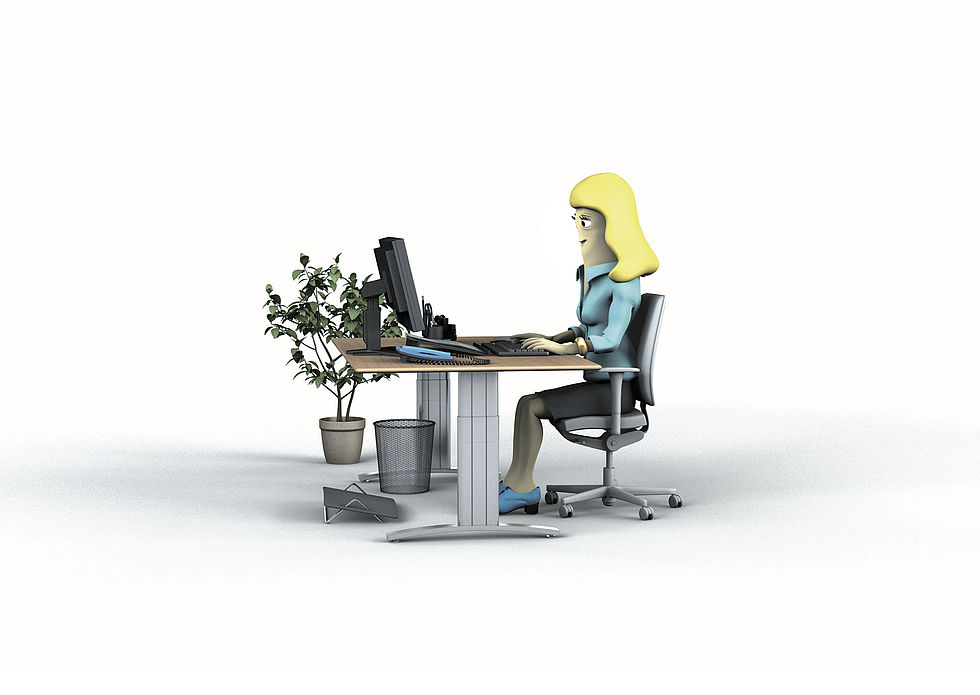


“This office table has style” or “This chair is a steal!” – attractive design or low prices are tempting when buying office furniture. However, objectively speaking, it is the ergonomic aspects that need to be considered when deciding for or against a particular piece of furniture. We have put together a list of points that should be considered when you are buying office furniture.
Would you buy a kitchen knife that does not cut properly but looks quirky or is particularly cheap? Probably not. If so, then sooner or later you will get annoyed about the fact that the knife is not fulfilling its function. It’s the same when buying office furniture. The sole difference is that the effects of unsuitable office furniture cannot be seen immediately. It is possible to use a wooden box to sit at a desk and work, but this solution only works for a short while. Relatively soon, bottom, back or neck will be calling painful attention to themselves. A good office chair should actually offer more than just a surface to sit on. In the same way, a table is not just a table, and a lamp not just a lamp.
A good office chair must be adjustable in height as well as in the depth of the seat pan. An adjustable chair back with a curve at the level of the small of the back (lumbar support) is indispensable to avoid putting strain on the back. Make sure when adjusting the chair back that it gives when pressure is put on it. Armrests are not absolutely necessary, but if the chair is fitted with them, they should be adjustable in order to take strain off the arms and shoulders and avoid any pinching between the armrests and the edge of the table. It is often forgotten that: if you do not use your ergonomic office chair correctly, then it is of little use to you. When adjusting the chair for the first time, make sure to sit up straight and use the whole seat pan, all the way to the back. This is the only way to keep all strain off the muscles in the back and neck.
Tip: If you are planning to buy ergonomic furniture for your office, test various products in a specialist shop. For example, you can try out office chairs for a week before taking a decision.
The same applies here: the table should be adjustable between a height of 65 and 85cm. Particularly when workstations are used by different people, the table must be able to be adjusted to the height of each user. The table top should not be made of a cold material like metal or glass. Reflective surfaces should also be avoided as they could rise to glare.
Tip: If there is already a table in the office that is too high for you and cannot be adjusted, you can also raise the height of your chair and achieve an ergonomic result using a footrest.
The right lighting is also part of creating an ergonomic workstation. Natural light and an individually adjustable lamp that does not cause glare are needed for work at the computer. Make sure that the light is neutral white or warm white and between 3300 and 5300 Kelvin (colour temperature). This is the optimal range for computer work. Good office planning should also take into consideration that lighting needs increase with age. Already at 45 one needs more light than earlier on in life. With workstation lighting that can be dimmed, the levels can be set as needed.
Tip: Do you have only limited possibilities to regulate the lighting conditions in your office? Then adjust the brightness of your computer screen.
It should be generally taken into account that the physical characteristics of every individual differ. The colleague who works next to you most likely differs from you in terms of height, build, eyesight and age. Accordingly he or she has different needs and therefore requires different products in order to work ergonomically. It is important to take time planning how the office should be furnished. This makes it possible to take individual needs into consideration, increase productivity and avoid or reduce possible consequences such as back pain, tension in the neck and shoulders, or headaches.